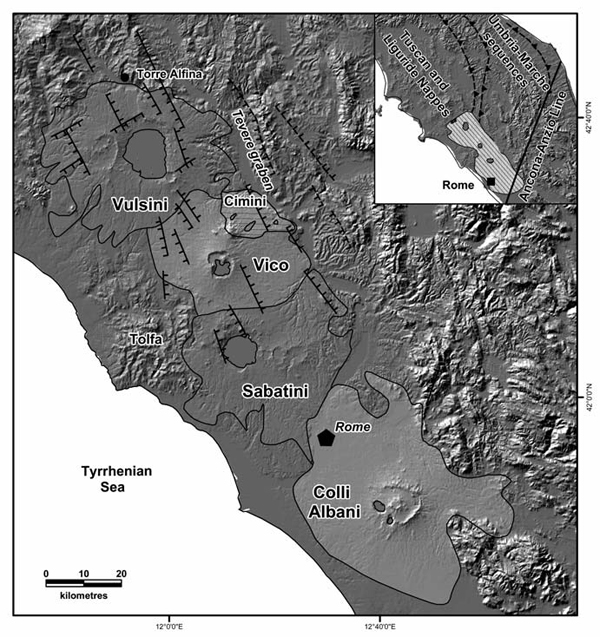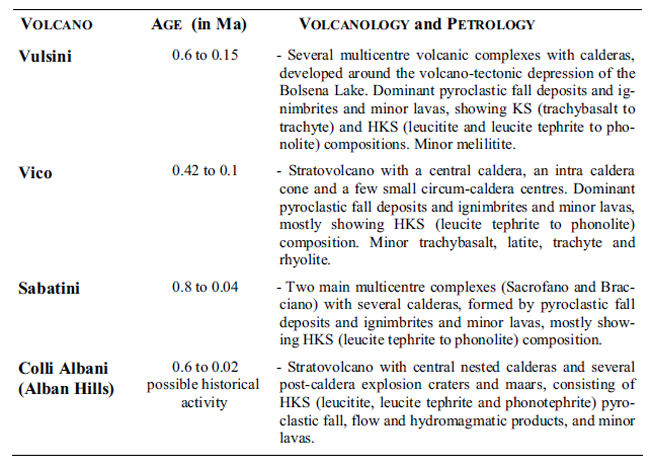Provincia magmatica Romana
Early in the 20th century, the Roman Province was defined by Washington (1906) as the large region of potassium-rich volcanism, extending from southern Tuscany to the Campania area. The Roman Province is formed by the large volcanic complexes of Monti Vulsini, Vico, Monti Sabatini and Colli Albani (Alban Hills), which together erupted about 900 km3 of volcanic products over a time span from about 800 ka to less than 20 Ka. In the north, these volcanoes are superimposed over the Tuscany magmatic rocks and there is evidence of hybridism between these two provinces in some places. The southern border of the Roman Province is marked by the Ancona-Anzio line, an important NE-SW trending tectonic line that crosses the Italian peninsula and divides the northern Apennines from Abruzzi-Latium sequences.The prevalent volcanism has been explosive, with numerous plinian eruptions and associated caldera and volcano-tectonic collapses. The rocks consist of large-volume pyroclastic deposits and minor lava flows. Thick ignimbrite sheets are particularly abundant and interesting, from both a geological and historical viewpoint, as they tend to form small plateau surrounded by steep cliffs, upon which several historical towns have been constructed. Moreover, the moderate degree of welding makes these rocks an excellent building material, locally known as "peperino", which has been extensively used since Etruscan and ancient Roman times.

Location map of volcanoes of the Roman Province. Inset: schematic structural map of northern Apennines. Peccerillo 2005
Petrologically, Roman Province volcanic rocks are mostly ultrapotassic and undersaturated in silica, but saturated to oversaturated potassic rocks occur in some places, especially in the Vulsini district and, to a lower extent, at Vico volcano. Evolved tephriphonolitic, phonolitic and trachytic rocks predominate over mafic types, except at Colli Albani where volcanic products range from tephrites and leucitites to phonotephrites.
The volcanoes of the Roman Province developed in a region characterized by Late Miocene-Quaternary extensional tectonics related to the eastward migration of Apennine mountain range and to the contemporaneous opening of the Tyrrhenian Sea. The volcanic zone is characterised by a system of Upper Miocene to Pleistocene NW-SE basins, developed along normal faults and intersected by strike-slip NE-SW fault.
Both fault systems represent zones of crustal weakness along which Roman potassic magmas were intruded. The pre-volcanic rocks consist of Tuscany, Liguride and Umbria-Marche allochthonous sequence, and of neoautochthonous Miocene to Quaternary shallow marine to continental clays, sands, and conglomerates filling post-orogenic extensional basins. The hypothesis that best explains the genesis of Roman mafic magmas suggests that they were generated by various degrees of partial melting at variable pressures of a lherzolitic mantle enriched in phlogopite by metasomatic processes. Geochemical data suggest that input of sedimentary material with a marly composition has been responsible for mantle metasomatism.
The hypothesis of mantle contamination by sedimentary material inevitably implies a subduction-related origin for the Roman Province. The timing of this process is debated, and ages ranging from 2.0 Ga to very recent times have been suggested. The Roman mafic rocks resemble closely the Intra-Apennine kamafugites for trace elements and radiogenic isotopes. This suggests that the same type and degree of metasomatic modifications affected the mantle sources of the IAP and Roman province. However, differences in the degrees of silica undersaturation, K2O/Na2O, CaO, Al2O3 and Na2O abundances point to somewhat different modal mineralogy for mantle sources and/or to variable pressure of partial melting.

Petrological-volcanological characteristics and ages of volcanoes in the Roman Province. Peccerillo 2005
Bibliography
• Peccerillo. A. Plio-Quaternary Volcanism in Italy. (2005)


